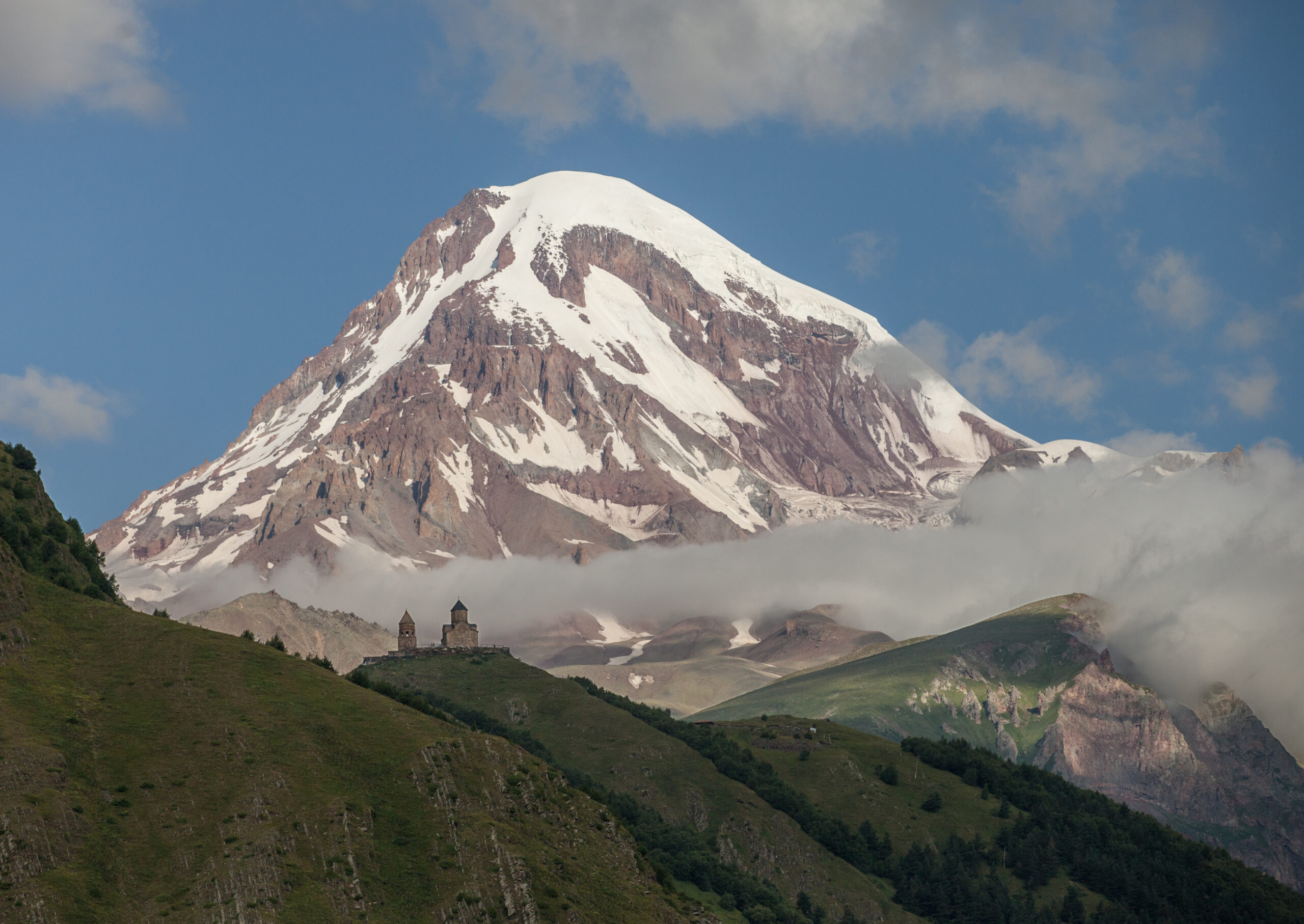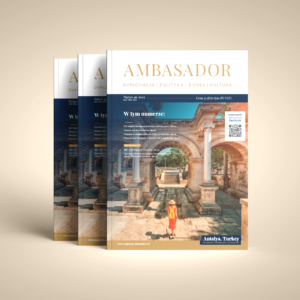A country friendly to Poles, colourful and with a rich culture. Georgia impresses with its natural and man-made creations.
When the sun is blazing in the summer in the town of Kazbegi, a glimpse of the nearby mountain with a similar name: Kazbek offers a cooling respite. Covered in eternal snow, the gigantic massif rises above the green, grassy and rocky mountains of this part of the Caucasus. This extinct volcano, 5047 metres above sea level, can be seen clearly from the town, and the impression is all the greater because the difference in altitude between the town and the summit is more than 3,000 metres. Looking from Kazbegi at the majestic peak, it is impossible not to notice the 14th century stone church, Tsminda Sameba (Holy Trinity), located on a nearby hill.
It is a symbolic sight as if looking through a lens showing everything that is most beautiful in Georgia – the mountainous landscape and centuries-old tradition. Kazbegi (the official name is Stepantsminda, but the locals prefer the traditional one) is visited both by mountaineers, ambitious to climb the great snow mountain, and tourists who are content to reach the church on foot or by taxi. However, even without special mountaineering preparation (but with good shoes), it is possible to follow the trail towards Kazbek and, within a few hours, reach the Alti Hut hut (at an altitude of about 3,000 metres), where you can spend the night in a real mountain atmosphere.
War-tourist trail
The Tsminda Sameba Church, on the other hand, is one of the many proofs of how long ago and how firmly rooted Christianity is in Georgia. Georgia was baptised as early as 337 AD by King Mirian, who ruled Iberia (by no means Spain, but a land of current eastern Georgia). During the Middle Ages, a multitude of stone churches were built throughout the country, often serving as defensive fortresses. And these, even for non-believers, are Georgia’s treasure. Especially in summer, when the country is plagued by heat, the cool interiors of these thick-walled churches offer respite and encourage reflection.
In order to reach the foot of Kazbek from Tbilisi and see the various attractions along the way, it is best to plan a whole day’s journey with stops along the so-called Georgian War Road. This is one of the most interesting routes in Georgia, leading from Tbilisi north to Kazbegi and on to the Russian border. The War Road was laid out in the 19th century, during the Russian conquest of the Caucasus, and has been maintained ever since. These days it can be driven all year round, even when it snows in its mountainous parts.
The first stop could be the town of Mtskheta – the former capital of the aforementioned Iberia, with its beautiful Svetitskhoveli Cathedral. Another must-see stop is the Ananuri fortress from the turn of the 16th and 17th centuries, which is a classic combination of religious and defensive structures. It is located on Lake Zhinvali – admittedly artificial, but extremely beautifully filling the Aragvi River valley. It may be somewhat reminiscent of our Bieszczady Lake Solina, except that it is much more powerful.
Another important stop on the War Road should be the village of Pasanauri. Not all guidebooks and tourist offices mention it, yet some of the best restaurants with local cuisine in all of Georgia can be found here. It is much cheaper here than in the big cities, and the khinkali or khachapuri egg pancakes are delicious.
Those who visit Georgia in winter should stop by the ski resort of Gudauri, located on the War Road. It offers around 60 km of ski pistes, and snow cover lasts from the end of November to the beginning of May.
Warm capital
Of course, it is impossible not to mention Tbilisi itself – a metropolis of one million people with many monuments and other attractions. It is one of the oldest cities in the world, with traces of settlement dating back five thousand years. The name comes from the Georgian adjective “tbili”, meaning “warm”, and refers, not coincidentally, to the warm sulphurous springs that bubble up here. Anyway, anyone can take advantage of this warmth in the generally accessible baths, which are a traditional pastime for tourists visiting the Georgian capital.
There is no shortage of attractions for the soul either. It is worth taking a walk through the streets of the oldest part of the city, under the hill with the Narikala fortress. There is a lot of traditional wooden and stone architecture here, well-preserved in some places and leaning towards the ground in others. The Kote Abkhazi shopping promenade, leading in an arc from the town hall’s Freedom Square to Gorgasali Square, is very popular. Along the way, visit the numerous wine bars offering the finest varieties of Georgian wine. South of Gorgasali Square you will find the aforementioned sulphur baths, as well as a great variety of temples: a Shiite mosque, an Armenian church and the Great Synagogue.
It is in this area that the Sioni Cathedral is located. For Georgians, it is the most important temple, where a precious relic is kept – the cross of Saint Nino. A native of Cappadocia, the saint, according to legend, wove a cross from vine branches, bound with a lock of hair. Its arms are not completely horizontal – they fall slightly downwards. And it is crosses like this that can be found on temples and roadside shrines throughout Georgia. Usually, the sign of the Orthodox faith is associated with a cross composed of a vertical, horizontal and diagonal beam, but Georgians have their own, originating precisely from Saint Nino. She had a part in the Christianisation of the country in the 4th century AD.
To mineral and sea waters
For tourists visiting Georgia who only have a few days – the above mountain and city itinerary gives
a little taste of the country. Whoever has more time for the mountains – should visit the Svaneti region, near the main ridge of the Caucasus, with the dynamically developing Mestia resort in recent years. Those who prefer slightly smaller mountains, known as the Lesser Caucasus, can head to the resort of Borjomi, which is closer to Tbilisi. The name is not coincidentally associated with Georgia’s most famous mineral water, also available in Poland – its springs are located here.
Those who prefer resting by the sea – and a warm one at that – can visit Georgia’s most famous Black Sea resort – Batumi. I. myself, have not been there, but I have heard from many sources that the atmosphere there is more like Las Vegas than Kołobrzeg. Those who prefer a seaside holiday without the glitz and glamour, fortunately have an alternative: beaches in the smaller seaside towns of Ureki and Kobuleti, where the tourist infrastructure is also rich. The coastal city of Sukhumi was also once a popular resort, but today it is difficult to enter. Sukhumi is the capital of the separatist republic of Abkhazia, which is likely to continue to receive visitors from Russia rather than the rest of the world for a long time to come.
Near the town of Gori (about 90 km west of Tbilisi), the rock city of Uplistsikhe is worth seeing. It is one of Georgia’s most valuable historical monuments, somewhat reminiscent of Jordan’s Petra. Carved into the rocks, the settlement was already a powerful centre of local power in the 10th century BC, and existed until the 14th century AD. And although its remains were partially destroyed by the 1920 earthquake, its rock caverns can still be admired.
Museum cult of the individual
Gori itself is also famous for its quaint Joseph Stalin museum. He originated from here, and his cult is still alive, despite the general knowledge of his crimes. Why? The answer can be found in Wojciech Górecki’s excellent book Toast to the Ancestors (Czarne Publishing House, 2010). The author, a Polish diplomat and journalist, quotes people toasting him there: ‘this man reversed the entire world order, and elevated us Georgians to the level we deserve’.
Turning a blind eye to these national weaknesses towards the dictator’s compatriot, it is nevertheless worth making friends with a Georgian, taking up the invitation to his home and having a glass of wine. For Poles are warmly welcomed there. And although neither Georgians nor Poles have lately harboured warm feelings towards their common great neighbour, his language – Russian – is very helpful in establishing contact. Just one of the South Caucasus paradoxes.
Lorem ipsum dolor sit amet, consectetur adipiscing elit, sed do eiusmod tempor incididunt ut labore et dolore magna aliqua. Tellus in metus vulputate eu scelerisque felis imperdiet proin. Non blandit massa enim nec dui nunc mattis enim. Vestibulum rhoncus est pellentesque elit ullamcorper dignissim. Nulla porttitor massa id neque aliquam vestibulum. Odio euismod lacinia at quis risus sed vulputate odio. Laoreet sit amet cursus sit amet dictum. Elementum curabitur vitae nunc sed velit dignissim. Pulvinar elementum integer enim neque volutpat ac tincidunt vitae. Elementum integer enim neque volutpat ac tincidunt vitae semper quis. Leo vel orci porta non.



Sledź nas na: